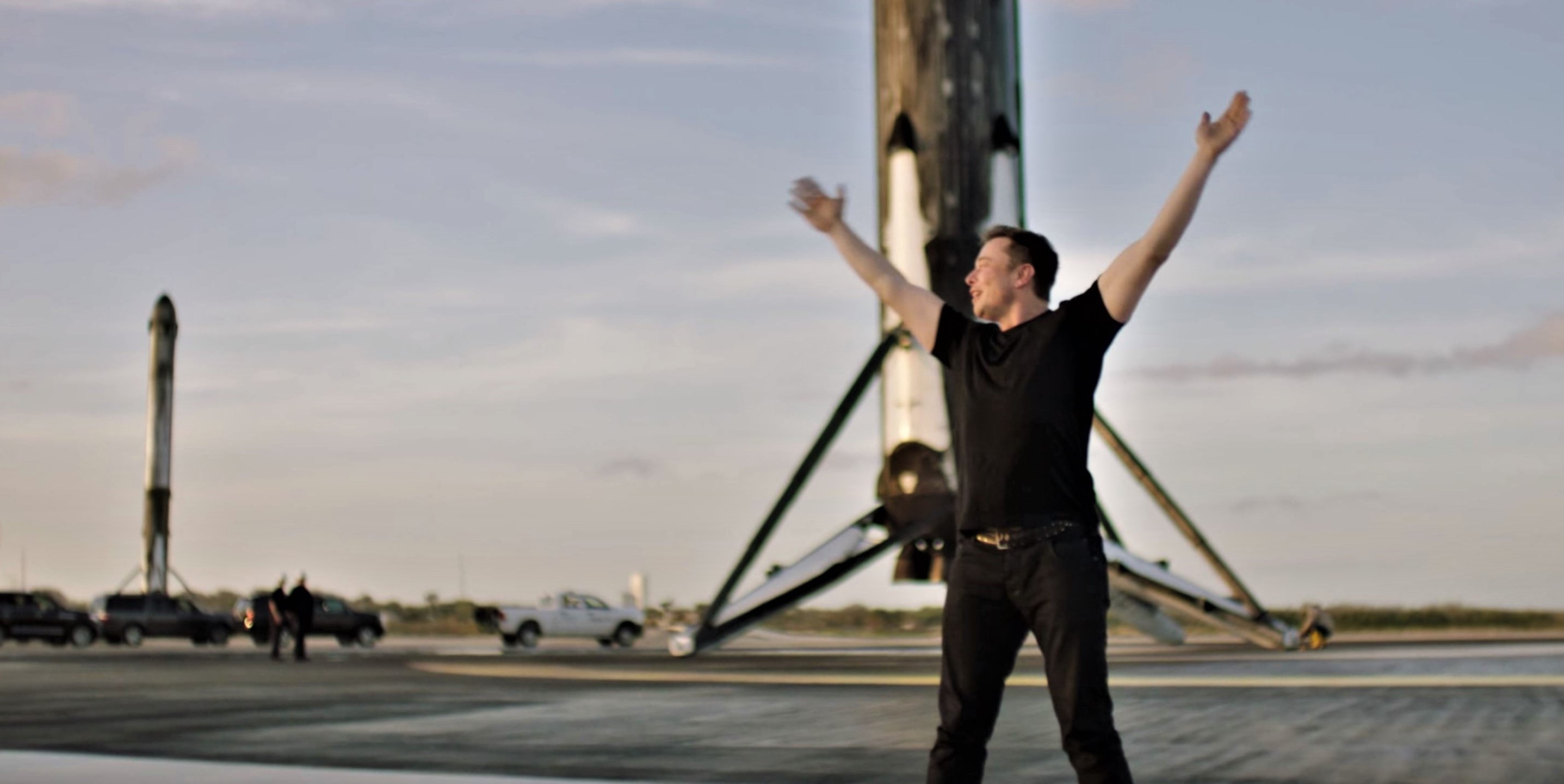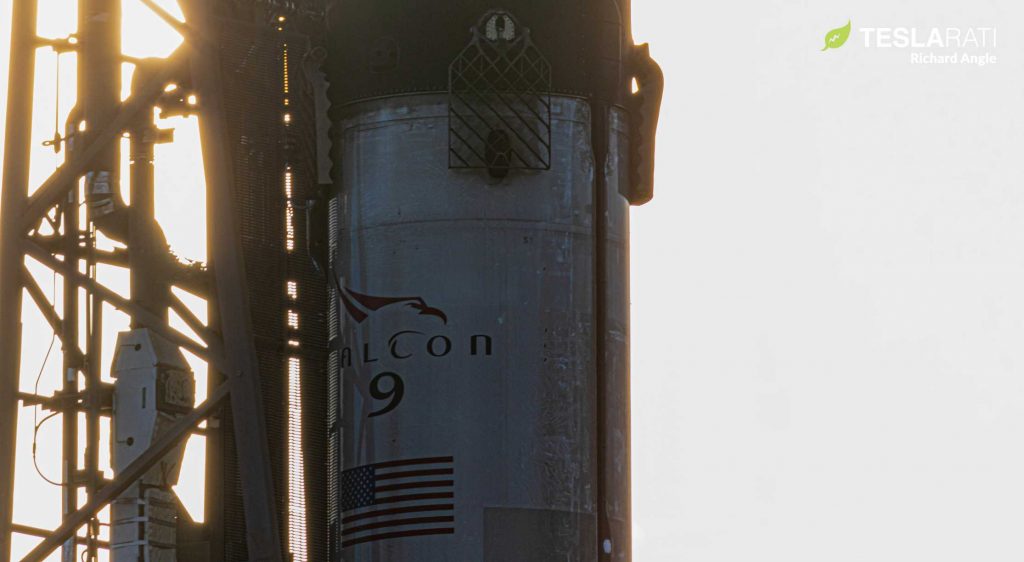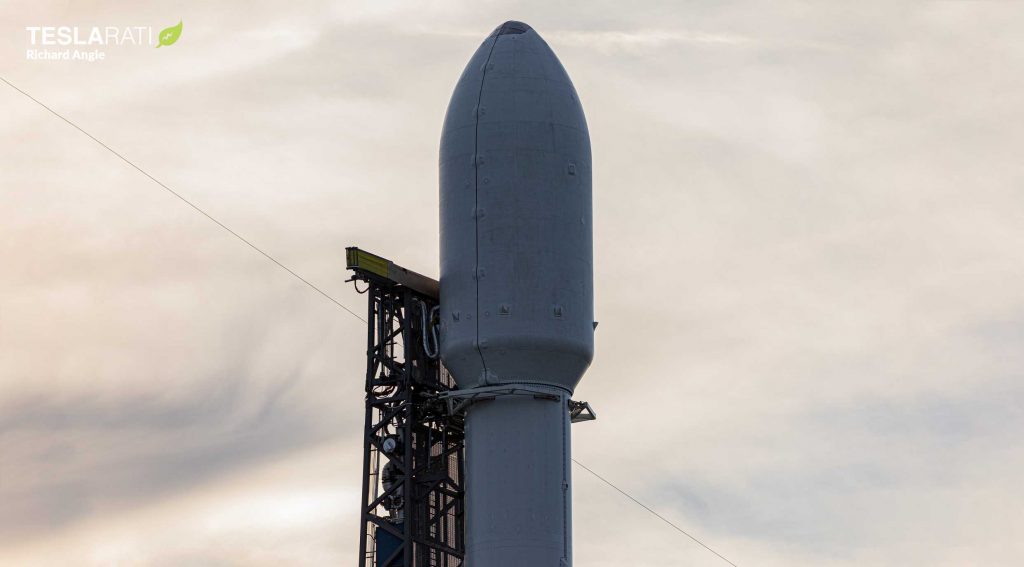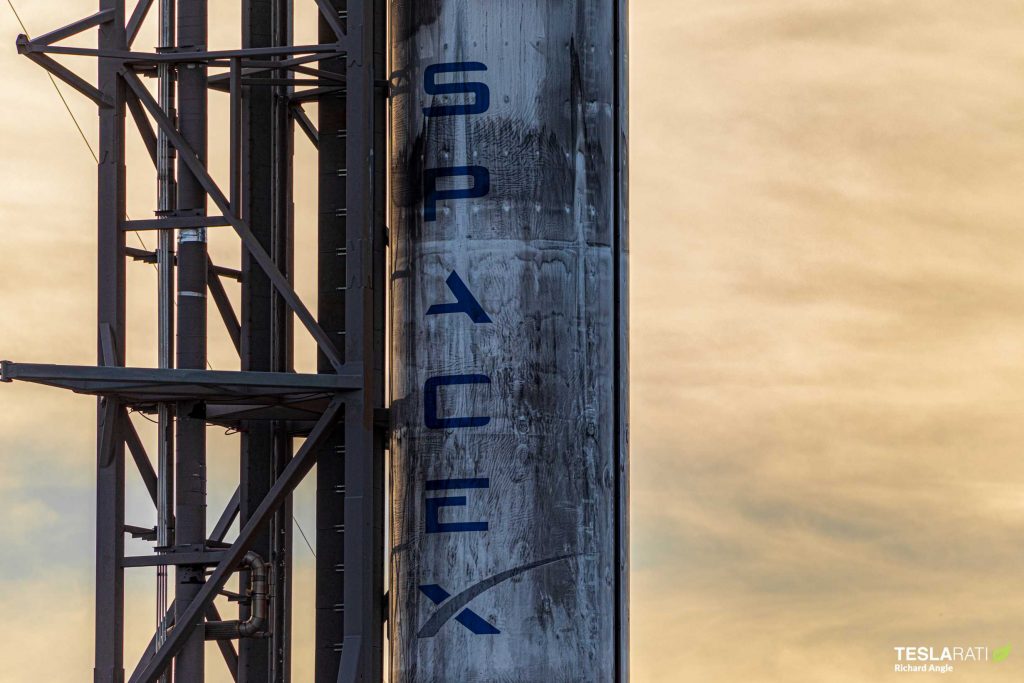

News
SpaceX’s Elon Musk set for Starlink launch, Tesla earnings double-header
SpaceX has delayed its latest Starlink launch once more after high winds forced the company to recycle an attempt originally planned for January 27th, setting up SpaceX’s Elon Musk for a Starlink launch and Tesla earnings report on the same day.
Flight-proven Falcon 9 booster B1051 is currently vertical at Cape Canaveral Air Force Station (CCAFS) Launch Complex 40 (LC-40) and has been for more than a week. Perched atop an expendable upper stage attached to the top of the booster, SpaceX’s third batch of 60 upgraded Starlink v1.0 satellites are loaded inside the rocket’s airtight payload fairing, patiently awaiting a launch that’s now been delayed a full 9 days by winter weather both in Cape Canaveral and off the Florida coast.
Most recently, bad sea conditions in the Atlantic Ocean forced SpaceX to delay Starlink V1 L3 an extra 24 hours from a January 28th backup window and the batch of communications satellites are now scheduled to launch no earlier than (NET) 9:09 am EST (14:09 UTC), January 29th. Set to unequivocally reaffirm SpaceX’s position as the owner of the world’s largest private satellite constellation, the mission – should it be a success – will mean that the company has launched its 240th flat-packed Starlink satellite. Additionally, Starlink L3 should feature a number of exciting Falcon 9 recovery events, potentially setting up more than 75% of the rocket’s value for reuse.
Earlier this morning, Teslarati’s own Simon Alvarez offered a glimpse of what to expect from Tesla’s Q4 2019 earnings report, scheduled for 3:30 PM PST (23:30 UTC), January 29th. In short, it looks like Tesla’s highly-anticipated Model Y crossover could find its way to customers much sooner than expected, while additional signs point to another strong quarterly performance that could send the company’s already meteoric stock even higher. As always, CEO Elon Musk is expected to be front and center on the teleconference, which is set to occur just nine hours after SpaceX’s latest 60-satellite Starlink launch.
For SpaceX, the new year has gotten off to a busy start, although Florida’s winter weather has done its best to hamper launch attempts. Beginning with the second launch of Starlink v1.0 satellites (Starlink V1 L2) on January 7th, that Falcon 9 mission was delayed from January 3rd by high seas in the Atlantic Ocean that would have made the booster’s planned drone ship landing extremely risky. In high seas, drone ship decks pitch and buck, creating major uncertainty as Falcon 9 is unable to account for the deck movement.

If the floating landing pad is at the peak or trough of large swells when Falcon 9 is scheduled to land, there is a good chance that the rocket could either hit the deck too hard or cut off its engines before landing, falling a distance equivalent to the height of the swell onto the drone ship. Either scenario would pose a serious risk of damaging or even outright destroying a landing Falcon booster, cutting short any future prospects of reuse.
Most recently, SpaceX performed Crew Dragon’s second-ever launch on a Falcon 9 rocket, intentionally triggering an in-flight abort (IFA) some 90 seconds after launch to test the spacecraft’s ability to keep astronauts safe in even a near-worst-case scenario. That particular launch was also delayed a number of days by high seas in the region the spacecraft was expected to splash down in, conditions that would have severely hampered critical recovery work.
Now a little over a week after Crew Dragon’s successful January 20th Falcon 9 launch, SpaceX’s third launch of the year has been delayed repeatedly by both weather in the recovery area and weather at the launch pad. Originally expected to launch as early as January 20th, a slight Crew Dragon launch delay pushed it to the 21st, where it was then delayed again by high seas to January 24th, and a third time to January 27th. On January 27th, SpaceX got just 40 minutes away from liftoff before it scrubbed the attempt due to high upper-level winds above the launch pad.


Finally, on January 28th, SpaceX announced that bad weather in the recovery area had forced it to skip a backup window scheduled later that day, slipping another 24 hours to 9:09 am EST on January 29th. With any luck, this will be the last in an unusually long series of weather-related delays for the Starlink mission. Aside from Falcon 9 B1051’s third launch and (hopefully) landing, Starlink V1 L3 will also mark the second time ever that twin Falcon fairing recovery ships Ms. Tree and Ms. Chief will attempt to simultaneously catch both halves of a payload fairing — more than worth the wait.
Tune in to SpaceX’s official webcast around 8:55 am EST (13:55 UTC) tomorrow (Wednesday, Jan 29) to watch the company’s third launch of 2020 live.
Check out Teslarati’s Marketplace! We offer Tesla accessories, including for the Tesla Cybertruck and Tesla Model 3.
News
Tesla cleared in Canada EV rebate investigation
Tesla has been cleared in an investigation into the company’s staggering number of EV rebate claims in Canada in January.

Canadian officials have cleared Tesla following an investigation into a large number of claims submitted to the country’s electric vehicle (EV) rebates earlier this year.
Transport Canada has ruled that there was no evidence of fraud after Tesla submitted 8,653 EV rebate claims for the country’s Incentives for Zero-Emission Vehicles (iZEV) program, as detailed in a report on Friday from The Globe and Mail. Despite the huge number of claims, Canadian authorities have found that the figure represented vehicles that had been delivered prior to the submission deadline for the program.
According to Transport Minister Chrystia Freeland, the claims “were determined to legitimately represent cars sold before January 12,” which was the final day for OEMs to submit these claims before the government suspended the program.
Upon initial reporting of the Tesla claims submitted in January, it was estimated that they were valued at around $43 million. In March, Freeland and Transport Canada opened the investigation into Tesla, noting that they would be freezing the rebate payments until the claims were found to be valid.
READ MORE ON ELECTRIC VEHICLES: EVs getting cleaner more quickly than expected in Europe: study
Huw Williams, Canadian Automobile Dealers Association Public Affairs Director, accepted the results of the investigation, while also questioning how Tesla knew to submit the claims that weekend, just before the program ran out.
“I think there’s a larger question as to how Tesla knew to run those through on that weekend,” Williams said. “It doesn’t appear to me that we have an investigation into any communication between Transport Canada and Tesla, between officials who may have shared information inappropriately.”
Tesla sales have been down in Canada for the first half of this year, amidst turmoil between the country and the Trump administration’s tariffs. Although Elon Musk has since stepped back from his role with the administration, a number of companies and officials in Canada were calling for a boycott of Tesla’s vehicles earlier this year, due in part to his association with Trump.
News
Tesla Semis to get 18 new Megachargers at this PepsiCo plant
PepsiCo is set to add more Tesla Semi Megachargers, this time at a facility in North Carolina.

Tesla partner PepsiCo is set to build new Semi charging stations at one of its manufacturing sites, as revealed in new permitting plans shared this week.
On Friday, Tesla charging station scout MarcoRP shared plans on X for 18 Semi Megacharging stalls at PepsiCo’s facility in Charlotte, North Carolina, coming as the latest update plans for the company’s increasingly electrified fleet. The stalls are set to be built side by side, along with three Tesla Megapack grid-scale battery systems.
The plans also note the faster charging speeds for the chargers, which can charge the Class 8 Semi at speeds of up to 1MW. Tesla says that the speed can charge the Semi back to roughly 70 percent in around 30 minutes.
You can see the site plans for the PepsiCo North Carolina Megacharger below.

Credit: PepsiCo (via MarcoRPi1 on X)

Credit: PepsiCo (via MarcoRPi1 on X)
READ MORE ON THE TESLA SEMI: Tesla to build Semi Megacharger station in Southern California
PepsiCo’s Tesla Semi fleet, other Megachargers, and initial tests and deliveries
PepsiCo was the first external customer to take delivery of Tesla’s Semis back in 2023, starting with just an initial order of 15. Since then, the company has continued to expand the fleet, recently taking delivery of an additional 50 units in California. The PepsiCo fleet was up to around 86 units as of last year, according to statements from Semi Senior Manager Dan Priestley.
Additionally, the company has similar Megachargers at its facilities in Modesto, Sacramento, and Fresno, California, and Tesla also submitted plans for approval to build 12 new Megacharging stalls in Los Angeles County.
Over the past couple of years, Tesla has also been delivering the electric Class 8 units to a number of other companies for pilot programs, and Priestley shared some results from PepsiCo’s initial Semi tests last year. Notably, the executive spoke with a handful of PepsiCo workers who said they really liked the Semi and wouldn’t plan on going back to diesel trucks.
The company is also nearing completion of a higher-volume Semi plant at its Gigafactory in Nevada, which is expected to eventually have an annual production capacity of 50,000 Semi units.
Tesla executive teases plan to further electrify supply chain
News
Tesla sales soar in Norway with new Model Y leading the charge
Tesla recorded a 54% year-over-year jump in new vehicle registrations in June.

Tesla is seeing strong momentum in Norway, with sales of the new Model Y helping the company maintain dominance in one of the world’s most electric vehicle-friendly markets.
Model Y upgrades and consumer preferences
According to the Norwegian Road Federation (OFV), Tesla recorded a 54% year-over-year jump in new vehicle registrations in June. The Model Y led the charge, posting a 115% increase compared to the same period last year. Tesla Norway’s growth was even more notable in May, with sales surging a whopping 213%, as noted in a CNBC report.
Christina Bu, secretary general of the Norwegian EV Association (NEVA), stated that Tesla’s strong market performance was partly due to the updated Model Y, which is really just a good car, period.
“I think it just has to do with the fact that they deliver a car which has quite a lot of value for money and is what Norwegians need. What Norwegians need, a large luggage space, all wheel drive, and a tow hitch, high ground clearance as well. In addition, quite good digital solutions which people have gotten used to, and also a charging network,” she said.
Tesla in Europe
Tesla’s success in Norway is supported by long-standing government incentives for EV adoption, including exemptions from VAT, road toll discounts, and access to bus lanes. Public and home charging infrastructure is also widely available, making the EV ownership experience in the country very convenient.
Tesla’s performance in Europe is still a mixed bag, with markets like Germany and France still seeing declines in recent months. In areas such as Norway, Spain, and Portugal, however, Tesla’s new car registrations are rising. Spain’s sales rose 61% and Portugal’s sales rose 7% last month. This suggests that regional demand may be stabilizing or rebounding in pockets of Europe.
-

 Elon Musk2 weeks ago
Elon Musk2 weeks agoTesla investors will be shocked by Jim Cramer’s latest assessment
-

 Elon Musk2 days ago
Elon Musk2 days agoxAI launches Grok 4 with new $300/month SuperGrok Heavy subscription
-

 Elon Musk4 days ago
Elon Musk4 days agoElon Musk confirms Grok 4 launch on July 9 with livestream event
-

 News1 week ago
News1 week agoTesla Model 3 ranks as the safest new car in Europe for 2025, per Euro NCAP tests
-

 Elon Musk2 weeks ago
Elon Musk2 weeks agoA Tesla just delivered itself to a customer autonomously, Elon Musk confirms
-

 Elon Musk1 week ago
Elon Musk1 week agoxAI’s Memphis data center receives air permit despite community criticism
-

 News2 weeks ago
News2 weeks agoXiaomi CEO congratulates Tesla on first FSD delivery: “We have to continue learning!”
-

 News2 weeks ago
News2 weeks agoTesla sees explosive sales growth in UK, Spain, and Netherlands in June

















